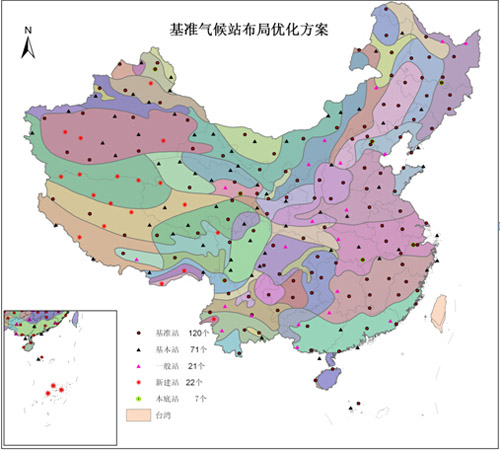Home>Features
22-09-2014Source:China Meteorological News Press
An integrated observing system is the basis for the provision of accurate, reliable and timely weather, climate, water and related environmental observations and products in a cost-effective and sustainable manner.
At present, CMA has a surface observation network composed of 2419 stations; weather radar network with 216 stations; upper air sounding network with 120 stations; 7 orbiting meteorological satellites; and also some specialized observing systems such as GAW, Agro-meteorology.

Newly planned distribution of national reference climate stations.
China Climate Observe System (CCOS) is an important component part of national integrated meteorological observing system. The development programme (2014-2020) of CCOS requires the establishment of a set of new climate observatories, which plays a core role to meet the need of numerical forecasting, climate and climate change operations. Chinese Academy of Sciences, departments of forestry, ocean, and education should be combined to cooperate, contributing to the building of these observatories, whose capacity also needs to be improved through ground, aerial and remote sensing observations. Integrated observation on the basic climate elements of atmosphere, land and ocean is necessary, while the experiments, equipment check and methods study are asked to be allotted to different departments to ensure the long term and continuous observation of the basic information of climate system.
In 2012, China Meteorological Administration (CMA) adjusted the layout of the climate reference stations countrywide. Attributed to the evaluation of the national surface weather stations and atmospheric composition stations, a net of 241 stations was formed, including the existing 120 reference stations, 74 basic stations, 21 general stations, 3 non-national background stations, and 22 newly built automatic climate stations, among which 13 are high-altitude while another 13 are on the islands. The amount of stations that have more than 50 years of history reaches 50, and that of the ones who has remained in the same spot for over half a century is 107.
After the adjustment, the national climate reference stations are now covering all 65 climate regions of China. In the mainland, there are reference stations in every 2.5 degree grid, with a more balanced distribution to meet the need of weather patterns.
|
|